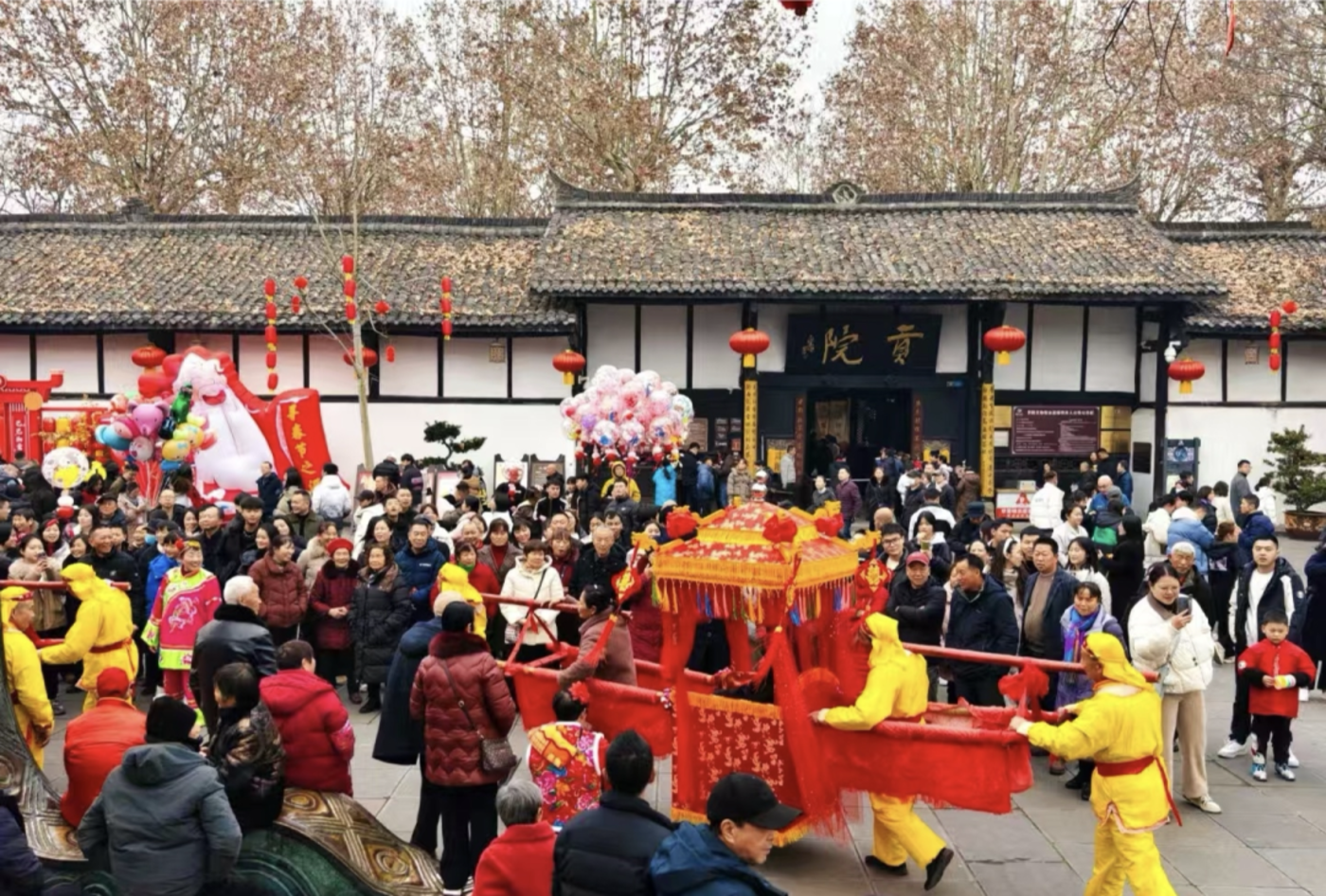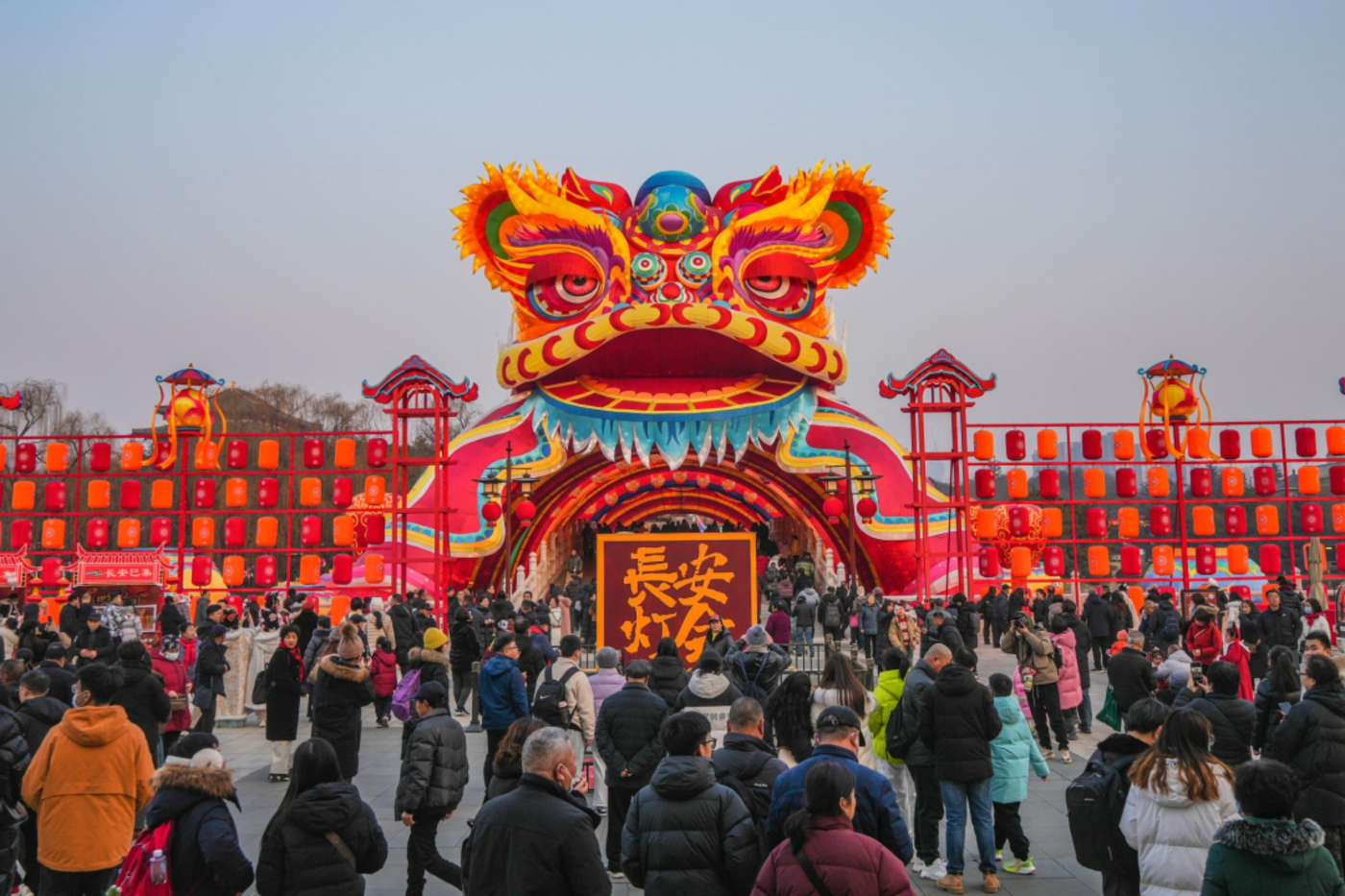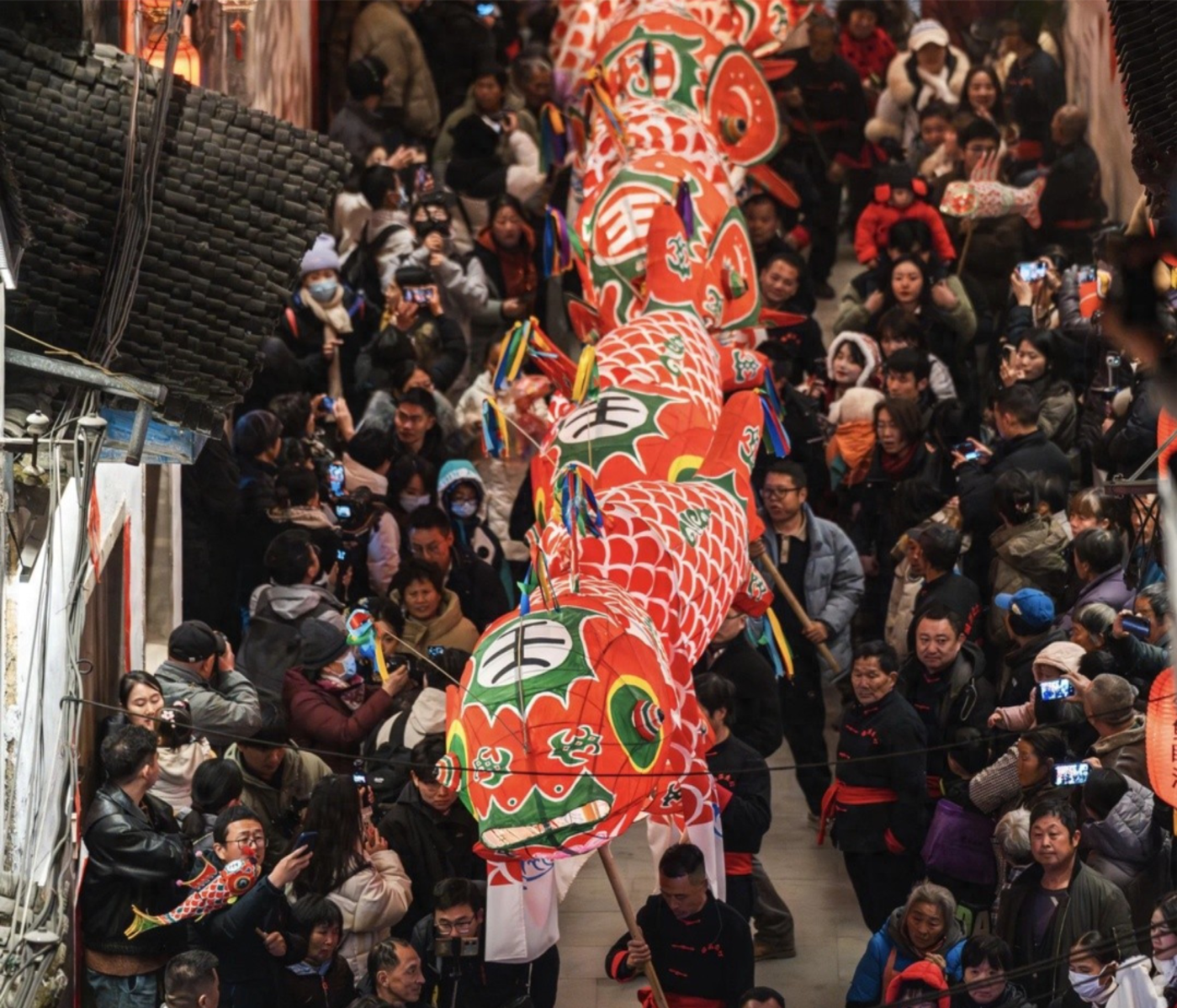Wen| Jingzhe Research Institute, author| early summer
With the resumption of leave and work, the Spring Festival holiday after the first successful application for a cultural heritage came to an end. During this year’s Spring Festival, the tourism market became hot again due to the spring breeze of intangible cultural heritage.
Data released by the Ministry of Culture and Tourism show that during the eight-day Spring Festival holiday this year, 501 million domestic trips across the country, a year-on-year increase of 5.9%; the total cost of domestic travel was 677.002 billion yuan, a year-on-year increase of 7.0%. The number of trips and total expenses across the country have reached new highs.
On the Flying Pig platform, the number of tourists including intangible cultural heritage project experiences and folk performances increased by 40% and 36% respectively year-on-year. Bringing relatives and friends to lantern festivals and enjoying folk performances has become popular tourism items. On the Tujia platform, the search volume for keywords such as Spring Festival folk cultural heritage increased by 4.2 times year-on-year during the Spring Festival.
When the Spring Festival encounters intangible cultural heritage, the New Year economy has become a new growth pole for the Spring Festival tourism market. For the cultural tourism industry, what new ideas has the addition of intangible cultural heritage buff brought?
Spring Festival tourism brings the most dazzling folk customs”
In recent years, on social media, during the Spring Festival, topics about the fading of the New Year have always been mentioned. On New Year’s Eve this year, when 1.4 billion viewers saw the Spring Festival Gala host constantly broadcasting the first intangible cultural heritage Spring Festival keywords, practitioners in the cultural and tourism industry should know that intangible cultural heritage tourism with a strong New Year flavor will become popular.
Meituan travel data shows that in the first five days of the Spring Festival holiday, the search volume for intangible cultural heritage increased by 212% year-on-year, the search volume for intangible cultural heritage experiences increased by 387%, the search volume for intangible cultural heritage manual increased by 790%, and the search volume for Spring Festival temple fairs increased by 633%.It is worth noting that nearly 40% of intangible cultural heritage searchers are young people born in 2000s. Compared with previous years, per capita post-00s has 1.2 more small stores, bringing more impetus to market growth.
The “2025 Spring Festival Consumption Data Report” released by Douyin on February 5 also mentioned that from New Year’s Eve to the sixth day of the first month, the order volume of intangible cultural heritage related group purchase products on the platform increased by 139% year-on-year, and the number of users purchasing intangible cultural heritage group purchase products increased year-on-year. 122%.
For the consumer market, the younger generation of consumers may not realize that folk activities such as temple fairs, dragon and lion dances, and stilt-walking, as well as traditional skills such as paper-cutting, New Year paintings, and sugar blowing, are all classified as intangible cultural heritage. However, in most people’s impressions, these traditional folk customs and skills are an important part of the flavor of the New Year.
Therefore, during the Spring Festival, bringing your family together to find the flavor of the New Year around you and taking an intangible cultural heritage trip that you want to go on has become a new choice for many people. Compared with the market demand reflected by online search data, the migration and consumption data generated by offline intangible cultural heritage tourism are more concrete.
For example, in the ancient city of Langzhong, Sichuan, Spring Festival customs with unique local characteristics, such as fighting dust, hanging red flags, opening eyes to door gods, and catching up with firecrackers, are staged in turn, attracting tourists from all over the world to experience it. On the first day of the holiday on January 28 (New Year’s Eve), the number of tourists to the ancient city of Langzhong reached 81,500, a significant increase of 139% year-on-year.

* Photo source: Langzhong Ancient City Official Weibo
With the arrival of tourists one after another, as of 14:00 on January 31, Langzhong Ancient City received a total of 556,900 tourists four days before the Spring Festival holiday, achieving ticket revenue of 5.4075 million yuan, an increase of 27.85% and 27.96% respectively compared with the same period in 2024.
“The popularity of intangible cultural heritage has not only brought an increase in ticket revenue to scenic spots, but also brought a large number of orders to related industries such as local hotels and catering.
Data from Muniao B & B shows that with the popularity of niche destinations such as Quanzhou, Zhangzhou, Shantou, Chaozhou, Jingdezhen, Liangshan, Fangchenggang, Yangjiang, and Yuxi, orders for local B & B have doubled year-on-year.
In Xi’an, which is hailed by netizens as the capital of carbohydrates and water, data from Meituan Platform shows that the number of catering orders arriving during the Spring Festival holiday increased by more than 40% year-on-year. The daily sales volume of Tongshengxiang mutton steamed buns exceeded 10,000 bowls, and the sales volume of gourd chicken in Xi’an Restaurant increased by more than 30% compared with usual.

* Photo source: Xi’an Cultural Tourism Official Weibo
According to public comment data, traffic from off-site users on the must-eat list in Fuzhou, Shantou, Quanzhou and other places has increased sharply. Among them, a local specialty stewed goose restaurant in Shantou receives an average of thousands of diners every day in the three days before the Spring Festival holiday, and sells more than 2000 intangible cultural heritage group purchase packages.
From scenic performances in intangible cultural heritage tourism destinations to local B & Bs and restaurants, tourists not only feel the long-lost flavor of the New Year during intangible cultural heritage tourism, but also taste unique local cuisine and deeply experience local culture.
Intangible cultural heritage buff activates new IP for county cultural tourism
In addition to bringing passenger flow and income to popular tourist cities and mature scenic spots, intangible cultural heritage buff also gives county cultural tourism a new IP.
In 2023, Zhao Liying’s fashion blockbuster shot inspired by Xunpu Women’s Headdress will amaze the Internet, and related topics will be on hot searches. Since then, many actresses such as Mao Xiaotong and Bailu went to Fujian to experience the intangible cultural heritage of hairpin flowers, which further increased the attention of hairpin flowers in Xiubu.

On the Douyin platform, Xunpu women’s topics have been played more than 1.5 billion times, while on the Xiaohongshu platform, Xiupu hairpin flowers have gradually become a popular travel photo item.Coupled with the romantic emotional connotation given by the sentence “Wear flowers in this life and be beautiful in the future, hairpin flower wai has become an intangible cultural heritage business card in Xupu Village, Quanzhou, Fujian Province. With the help of a large number of exquisite pictures and Short Video about Xunpu women’s hairpin flowers, extensive grass planting has been completed through social media.
During this year’s Spring Festival holiday, the popularity of Xiupu hairpin flowers, which have long been out of circulation on the Internet, remains unabated. Xiupu Village, with a permanent population of less than 10,000, has a cumulative passenger flow exceeding 431,800, with an average daily average of 54,000, a year-on-year increase of 19.3%.
Also relying on intangible cultural heritage is Zhanqi Village in She County, Anhui Province.
The Zhanqi fish lantern, which originated in the Song Dynasty, has a history of 800 years. In Xin Qiji’s famous piece “The Jade Case Yuan Xi”, the fish and dragon dance one night is about the fish lantern. In 2024, with the help of the dissemination of Short Video and live broadcast platforms, Zhanqi Fish Lantern will begin to attract the attention of netizens on the Internet. In a village evening live broadcast on January 10, 2025, 2.747 million viewers poured into the live broadcast room, making Zhanqi Fish Lantern explode overnight.
During the Spring Festival this year, Zhanqi Fish Lantern became the only way in Anhui to make the list of the top ten popular intangible cultural heritage travel methods for Meituan travel. According to CCTV. com, the team members performing the fish lantern dance in Zhanqi Village will perform three times a day starting from the second day of the year. In order to catch the traffic brought by the intangible cultural heritage fish lanterns, the local area of She County has added fish lantern performances in Huizhou Ancient City, Yuliang and Tangyue since the third day of the New Year.

* Photo source: Official public account of She County Cultural Tourism
Dancing fish lanterns under the night meet tourists from all over the world in the streets and alleys of Huizhou, illuminating the prospects for the development of local cultural tourism.
Data shows that during the Spring Festival this year, Zhanqi Ancient Village received 73,000 tourists, an increase of 457%. In She County, only nearly 10,000 fish lanterns were sold during the seven days of the Spring Festival, with sales exceeding one million yuan. Overnight, various fish lantern experience halls and noodle restaurants opened like bamboo shoots after rain, and cultural and creative products such as hairpins, brooches, refrigerator stickers, and sachets made with fish lantern elements have also brought diversified growth to the local cultural tourism industry.
In addition to the hairpin flowers on the crab and the fish lanterns on the Zhanqi River, the Chaoshan English songs and dances on the Spring Festival Gala in 2025 will drive a 114.5% year-on-year increase in cultural tourism orders in the Chaoshan region during the Spring Festival. Folk experiences such as local opera, lantern performance, and Wang Gong lifting in Anshun, Guizhou, and dragon lantern treading in Zhenyuan Ancient Town have also become popular local activities. Four days before the Spring Festival holiday, the hotels under Guilv Hotel achieved revenue of more than 3 million yuan., an increase of nearly 17% compared with the same period last year.
From the intangible cultural heritage projects that continue to emerge across the country, as well as the Spring Festival cultural tourism consumption data that is showing a growing trend, we can see that the Spring Festival holiday, intangible cultural heritage folk customs and young groups are the right time, place and people, allowing local cultural tourism to find new growth.
“Long-term business of the New Year economy
It is no accident that intangible cultural heritage has become a key word for cultural tourism during the Spring Festival.
From 2006 to 2021, the central government has spent more than 8.7 billion yuan on intangible cultural heritage protection.In 2024, the central government will allocate approximately 826 million yuan in national intangible cultural heritage protection funds, and this part of the funds will be included in the expenditures of the Ministry of Culture and Tourism.
Finance at all levels is also using real money to support intangible cultural heritage inheritors and support the development of intangible cultural heritage bases and workshops.For example, Kunming, Yunnan Province will allocate 675,000 yuan in national intangible cultural heritage protection funds in 2024, including 105,000 yuan for national-level representative inheritors of intangible cultural heritage and 570,000 yuan for the protection of representative intangible cultural heritage project “Dian Opera”. The Culture, Radio, Television, Tourism and Sports Bureau of Qingtian County in Lishui, Zhejiang Province has subsidized 50,000 yuan for each of the announced provincial-level intangible cultural heritage workshops, 20,000 yuan for each at the municipal level, and 5,000 yuan for each at the county level.
In addition to policy guidance and support, there have been many intangible cultural heritage projects that have used new media channels to expand market influence in recent years.
In the annual hit game “Black Myth: Wukong”, the phrase “Huang Fengling, Eight Hundred Miles” has made northern Shaanxi storytelling popular around the world; Chen Lijun’s Yue opera “New Longmen Inn”, led by Chen Lijun, uses the wonderful interpretation of the new characters to attract young audiences; Li Ziqi will resume its revision in November 2024 after leaving for three years. While winning the entire online hot search, he also allowed traditional skills such as intangible cultural heritage Sichuan embroidery, lacquer, and velvet flowers to be seen by netizens at home and abroad.

After several years of precipitation, the two-way synergy between policy guidance and market demand has made intangible cultural heritage tourism a new New Year economy this year.”。However, the prosperity of the new track has also given rise to some problems, especially when intangible cultural heritage has become a sign to attract online traffic and offline passenger flow, there has also been a phenomenon of touching intangible cultural heritage.
For example, some cities have invested huge sums of money to create man-made scenic spots with simple architectural styles, which are euphemistically called characteristic towns, and then invited foreign teams to perform intangible cultural heritage performances. Despite its intangible cultural heritage sign, it lacks the support of local culture and is still engaged in the middleman business of collecting tickets and selling stalls.
There are also many commercial districts that use intangible cultural heritage performances to attract traffic, but the quality of the performances is worrying and the on-site management is weak, making the real experience of tourists difficult to describe. Netizens come for intangible cultural heritage experiences and traditional markets, but the reality is that snack stalls with roasted sausage and stinky tofu play the leading role.
What needs to be pointed out in particular is that while intangible cultural heritage has become popular, there has also been a phenomenon of confusing real and fake intangible cultural heritage.
Many scenic spots have stalls with intangible cultural heritage painted fans, but actually sell water-transfer group fans, which have nothing to do with intangible cultural heritage. In the promotion and media reports of scenic spots, this kind of water-transfer group fan is often dubbed as an intangible cultural heritage experience.

In addition, although the national-level intangible cultural heritage fire pot performances that frequently appear in many commercial activities and even media reports are said to be derived from the national-level intangible cultural heritage wind and fire meteor in Taiyuan, Shanxi and the provincial intangible cultural heritage Qijiang charcoal flower dance in Hunan, there is no such item in the list of representative projects of national intangible cultural heritage.
From a positive perspective, these unclear intangible cultural heritage projects have attracted more people’s attention to intangible cultural heritage, but the risk of confusing true and false has also made the real intangible cultural heritage buried deeper, making it impossible to achieve the true purpose of protecting intangible cultural heritage.
Returning to the cultural tourism industry, the proliferation of intangible cultural heritage signboards will also encounter the problem of homogeneous competition. The same intangible cultural heritage performances and the tourism experiences brought by scenic spots NPCs are different. When low-quality performances consume consumers ‘interest and recognition of intangible cultural heritage tourism, then intangible cultural heritage is no longer a sign that tries everything., but a keyword on social media to remind other netizens to avoid traps and lightning protection.
It is true that with the support of the first intangible cultural heritage Spring Festival and intangible cultural heritage buff, the Spring Festival tourism market has undoubtedly found a new direction to create a New Year economy. However, after swarming and becoming popular, how to avoid a flash in the pan has become a question that cultural tourism in various places needs to seriously consider. Returning to the business nature of the tourism market with user experience as the core, adhering to long-term doctrine, and making more innovations and improvements in services, experiences and projects may be the basis for continuing the popularity of intangible cultural heritage tourism and the market growth trend.



